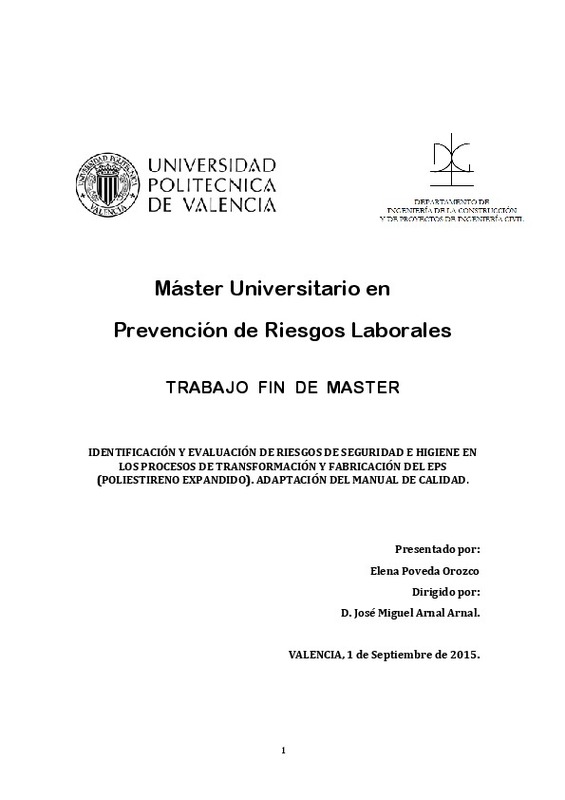JavaScript is disabled for your browser. Some features of this site may not work without it.
Buscar en RiuNet
Listar
Mi cuenta
Estadísticas
Ayuda RiuNet
Admin. UPV
Identificación y evaluación de riesgos de seguridad e higiene en los procesos de transformación y fabricación del EPS (poliestireno expandido). Adaptación del manual de calidad
Mostrar el registro sencillo del ítem
Ficheros en el ítem
| dc.contributor.advisor | Arnal Arnal, José Miguel
|
es_ES |
| dc.contributor.author | Poveda Orozco, Elena
|
es_ES |
| dc.date.accessioned | 2016-07-21T09:31:12Z | |
| dc.date.available | 2016-07-21T09:31:12Z | |
| dc.date.created | 2015-09-23 | |
| dc.date.issued | 2016-07-21 | |
| dc.identifier.uri | http://hdl.handle.net/10251/67955 | |
| dc.description.abstract | [EN] Expanded polystyrene, hereinafter EPS (Expanded Polystyrene) is a petroleum derivative. Polystyrene is a polymer of styrene, together with the hydrocarbon blowing agent pentane C5H12 and water give EPS. Polystyrene was first synthesized at an industrial level in 1930. The BASF company, in the early 50s, industrially developed and produced a new product called expandable polystyrene, under the trademark Styrofoam, still used today. Its versatility have made that this material it is used in many applications and expanded its use worldwide. In this Masther Science Thesis we have tried to give an overview of the uses and applications of EPS. Likewise, we have performed an identification and risk assessment in a processing plant of such material. Moreover, the obtained results have been used in theadaptation of the Quality Manual of the company including those sections omitted about the prevention of occupational hazards, thus meeting the objectives of our work. | es_ES |
| dc.description.abstract | [ES] El Poliestireno Expandido, en adelante EPS (Expanded PolyStyrene) es un derivado del petróleo. El poliestireno es un polímero del estireno, que junto con el agente expansor hidrocarburo pentano C5H12 y agua dan lugar al EPS. El poliestireno fue sintetizado por primera vez a nivel industrial en 1930. Posteriormente la marca BASF, en la década de los años 50, desarrolló y produjo industrialmente un nuevo producto llamado poliestireno expandible, bajo la marca Styropor, aún utilizada actualmente. Dada su versatilidad, es un material usado en infinidad de aplicaciones, por ello desde su creación, se ha expandido su utilización mundialmente. En este trabajo se ha pretendido dar una visión global de los usos y aplicaciones del EPS. Así mismo, se ha realizado una identificación y evaluación de riesgos en una fábrica transformadora de dicho material. Además, con los resultados extraídos se ha realizado la adaptación del Manual de Calidad de la empresa incluyendo aquellos apartados que omitía en materia de prevención de riesgos laborales, cumpliendo así con los objetivos marcados. | es_ES |
| dc.format.extent | 149 | es_ES |
| dc.language | Español | es_ES |
| dc.publisher | Universitat Politècnica de València | es_ES |
| dc.rights | Reserva de todos los derechos | es_ES |
| dc.subject | Prevencion de riesgos laborales | es_ES |
| dc.subject | Poliestireno expandido | es_ES |
| dc.subject | Manual de calidad | es_ES |
| dc.subject | Expanded polyestyrene | es_ES |
| dc.subject | Occupational hazards prevention | es_ES |
| dc.subject | ; Quality Manual | es_ES |
| dc.subject.classification | INGENIERIA QUIMICA | es_ES |
| dc.subject.other | Máster Universitario en Prevención de Riesgos Laborales-Màster Universitari en Prevenció de Riscos Laborals | es_ES |
| dc.title | Identificación y evaluación de riesgos de seguridad e higiene en los procesos de transformación y fabricación del EPS (poliestireno expandido). Adaptación del manual de calidad | es_ES |
| dc.type | Tesis de máster | es_ES |
| dc.rights.accessRights | Abierto | es_ES |
| dc.contributor.affiliation | Universitat Politècnica de València. Servicio de Alumnado - Servei d'Alumnat | es_ES |
| dc.description.bibliographicCitation | Poveda Orozco, E. (2015). Identificación y evaluación de riesgos de seguridad e higiene en los procesos de transformación y fabricación del EPS (poliestireno expandido). Adaptación del manual de calidad. http://hdl.handle.net/10251/67955 | es_ES |
| dc.description.accrualMethod | Archivo delegado | es_ES |






